The 800 lb. Gorilla in the Ocean
When most of us think of climate change and global warming we think of the atmosphere – warmest decades on record recently, atmospheric CO2 at record levels and climbing, increased floods, droughts, hurricanes, melting glaciers, etc. When we do speak about the oceans, it is typically about heat content, Arctic ice melt, and sea level rise. However, the 800 lb. gorilla in the room just might be ocean acidification.
The ocean has absorbed about half of all the anthropogenic (human) carbon emissions since the beginning of the Industrial Revolution (Doney, 2006). The CO2 that the oceans absorb is causing a lower pH which means the oceans are moving toward more acidic conditions. The consequences could be dire.
Where Do Carbon Emissions End Up
The figure below (Ruddiman, 2008) shows where the carbon emissions end up. Fossil fuel burning and land clearance are sources of carbon while the oceans and land (primarily due to vegetation) are sinks for carbon. The measured amount of carbon in the atmosphere is only 55% of what is actually being emitted into the air.
According to the Global Carbon Project (2009):
The global oceanic CO2 sink removed 26% of all CO2 emissions for the period 2000-2008, equivalent to an average of 2.3 GtC per year. While the total amount of CO2 being removed by the ocean is increasing, its efficiency (the fraction removed of the total emissions) appears to have been declining over the last two decades partially owing to the decline in efficiency of the Southern Ocean and North Atlantic Ocean where long term field observations and model results appear to be in agreement. In 2008, the oceans removed an amount of CO2 slightly below average.
The amount of CO2 that is absorbed by the oceans is a function of water temperature, pressure, and salinity (salt content) known as the solubility pump and biological processes known as the biological pump. Colder, saltier water absorbs more CO2 while warmer, less salty water absorbs less CO2. There are various complex factors that control the biological pump and these are shown below.
Careful measurements show that the bulk of the CO2 being absorbed by the oceans resides in the shallowest layers (Doney, 2006).
Ocean Chemistry:
When carbon dioxide is absorbed by the oceans, it forms carbonic acid (H2CO3), the same weak acid found in carbonated beverages. Carbonic acid then releases hydrogen ions (H+) into solution which lowers the pH of the water. The full chemical reaction ends up leaving both bicarbonate ions (HCO3–1) and, to a lesser extent, carbonate ions (CO3–2).
The normal pH of sea water in perfect conditions ranges between 8.0 and 8.3 (slightly alkaline). The pH of the oceans has already decreased 0.1 from pre-Industrial values due to the absorption of anthropogenic CO2 and the projections are for the pH to lower an additional 0.3 by 2100 if emissions go unabated (Ibid).
Although these changes appear to be small, these small pH changes may cause devastating effects on sea creatures that need carbonate ions to build their calcium carbonate shells. The excess H+ ions combine with carbonate ions to make bicarbonate. The result is less and less carbonate for shelled sea creatures.
The Shell Game:
Plankton is the base of the marine food chain. Coccolithophorids, which are covered with small plates of calcium carbonate and are commonly found floating near the surface of the ocean (where they use the abundant sunlight for photosynthesis) are in danger with slightly lower pH values. Other potentially endangered planktonic organisms are foraminifera and pteropods. These life forms constitute a major food source for fish and marine mammals, including some species of whales. And, of course, humans and other animals rely on a robust marine food chain.
The abundance of commercially important shellfish species (i.e., clams, oysters, sea urchins) could also decline, which could have serious consequences for marine food resources (Cooley et al., 2009).
Corals are also endangered with lower pH. Corals are essentially calcium carbonate skeletons of the creatures that live inside them. Coral reefs are the most productive and biologically diverse ecosystems in the ocean. Coralline algae (algae that also secrete calcium carbonate and often resemble corals) contribute to the calcification of many reefs, too. The Great Barrier Reef off the coast of Australia, for instance—the largest biological structure in the world—is simply the accumulation of generation after generation of coral and coralline algae. Less obvious examples occur deeper down in the sea, where cold-water coral communities dot continental margins and seamounts, forming important fish habitats (Doney, 2006).
The calcium carbonate in corals or in the shells of other marine creatures comes in two distinct mineral forms: calcite and aragonite. Aragonite and magnesium calcite are more soluble than normal calcite. Thus, corals and pteropods, which both produce aragonitic shells, and coralline algae, which manufacture magnesium calcite, may be especially susceptible to harm from ocean acidification (Ibid).
The saturation horizon is the level below which aragonite and calcite begin to dissolve. The influx of carbon dioxide from the atmosphere has caused the saturation horizons for aragonite and calcite to shift closer to the surface by 50 to 200 meters compared with where they were positioned in the 1800s. As the ocean becomes more and more acidic less and less of the sea will remain hospitable for calcifying organisms (Ibid).
The outlook for coral reefs is bleak. For those precious ecosystems, ocean acidification is but one of many environmental stresses, an onslaught that includes greenhouse warming, local pollution, over-fishing and habitat destruction. Many coral reefs are already in decline, and ocean acidification may push some over the edge into nonexistence (Ibid).
Any Good News?
Phytoplankton need dissolved CO2 and nitrogen (N2) to thrive. These organisms may benefit from increased levels of those dissolved gas. Some plants such as sea grasses may also thrive due to CO2 fertilization. Fu et al. (2008) note that several studies (Hutchins et al., 2007; Levitan et al., 2007; Ramos et al., 2007) have shown significant increases in N2 fixation and photosynthesis in response to elevated CO2. They conclude that anthropogenic CO2 enrichment could substantially increase global oceanic N2 and CO2 fixation which would increase certain types of phytoplankton but only if there is enough iron (Fe) availability.
However, according to David Hutchins (2010), Professor of Marine Environmental Biology, University of Southern California, USA, “Some of the experiments that have been done so far suggest that the likely new dominant phytoplankton species in the future acidified ocean may be less able to support the productive food chains that we presently rely on to support healthy ocean ecosystems and fisheries resources.”
Iron and the Carbon Sink:
Sunda (2010) and Shi et al. (2010) have noted that the acidification of the oceans may decrease the biological availability of iron which would reduce the ability of phytoplankton such as diatoms to absorb CO2. These organisms play an important role in the ocean carbon sink. Shi et al. found that the projected pH decrease by the year 2100 would reduce iron uptake by diatoms by 10% to 20%. In addition, warmer ocean temperatures due to global warming do not allow as much dissolved CO2 gas to be present. According to the Global Carbon Budget (2008), “While the total amount of CO2 being removed by the ocean is increasing, its efficiency (the fraction removed of the total emissions) appears to have been declining over the last two decades…”” The oceans are already struggling to keep up with human emissions.
The figure below shows representative examples of impacts of ocean acidification on major groups of marine biota derived from experimental manipulation studies. The response curves on the right indicate four cases: (a) linear negative, (b) linear positive, (c) level, and (d) nonlinear parabolic responses to increasing levels of seawater pCO2 for each of the groups (adapted from Doney et al., 2009).
Marine Oxygen Holes:
Hoffman and Schellnhuber (2009) in their paper, Oceanic acidification affects marine carbon pump and triggers extended marine oxygen holes, modeled ocean acidification into the future assuming a business as usual CO2 emission scenario. Their research shows that by the year 2200 with atmospheric CO2 levels reaching 1750 ppm, the sea-surface pH value drops by >0.7 units on global average, inhibiting the growth of marine calcifying organisms. They also found that as organic matter is oxidized in shallow waters when the carbon pump weakens, oxygen holes (hypoxic or dead zones) start to expand considerably in the oceans in the future—with potentially harmful impacts on a variety of marine ecosystems.
I am an optimist so I think that society will realize the consequences of increased CO2 well before reaching 1750 ppm CO2 however, the image above is a sobering reminder of what might happen in a worst-case scenario future.
The Unknowns:
When one reads Impacts of Ocean Acidification on Coral Reefs and Other Marine Calcifiers: A Guide for Future Research, (Kleypas et al., 2006) it becomes quite clear that the impact of ocean acidification on marine life is uncertain because it is essentially a fledgling field. It was not part of the IPCC TAR (2001) however the IPCC Fourth Assessment Report on Climate Change (2007) stated in the Summary for Policy Makers, “The progressive acidification of the oceans due to increasing atmospheric carbon dioxide is expected to have negative impacts on marine shell-forming organisms (e.g. corals) and their dependent species.” Ocean acidification and its impact will be seriously addressed by the Fifth Assessment Report of the IPCC to be released in 2013.
The Knowns:
According to Iglesias-Rodriguez, Doney, Widdicombe, Barry, Caldeira, & Hall-Spencer (2010): “The rate of human-driven ocean acidification is about 100 times faster in the surface ocean than that experienced by marine ecosystems globally for tens of millions of years.”
According to Barry, Schmidt, & Caldeira (2010): “Other than at times of the great mass extinctions, there is no evidence in the geologic record for sustained rates of change in atmospheric CO2 that have been as great or greater than today’s. Even during extreme ocean chemistry changes in geological history— for example, during the Paleocene/Eocene thermal maximum (PETM) 55 million years ago when carbonate minerals dissolved in most of the deep and intermediate ocean—these changes probably happened over several thousands of years. In general, ocean life recovers from extinction episodes by adaptation and evolution of new species, but this takes roughly 10 million years to achieve pre-extinction levels of biodiversity.”
Although much is unknown, it seems clear that humans are altering the oceans in a manner unique to their history and to the history of the marine life within. Just as the grand experiment we are undertaking with the climate, we are doing the same with the oceans. The results of both of these experiments will likely be harmful to life on this planet.
I see a large gorilla in the ocean that cannot be ignored.
Helpful Resources:
Frequently asked questions about ocean acidification
The Dangers of Ocean Acidification
Ocean Acidification: A Critical Emerging Problem for the Ocean Sciences
PMEL Ocean Acidification Home Page
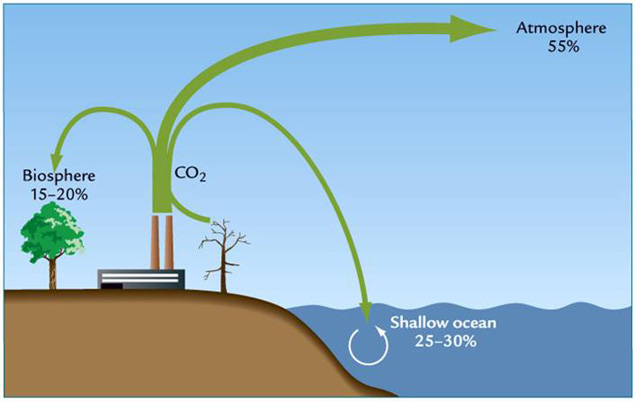
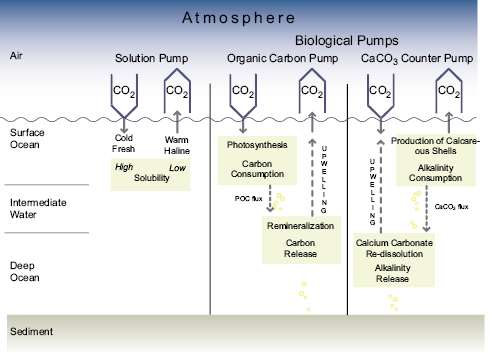
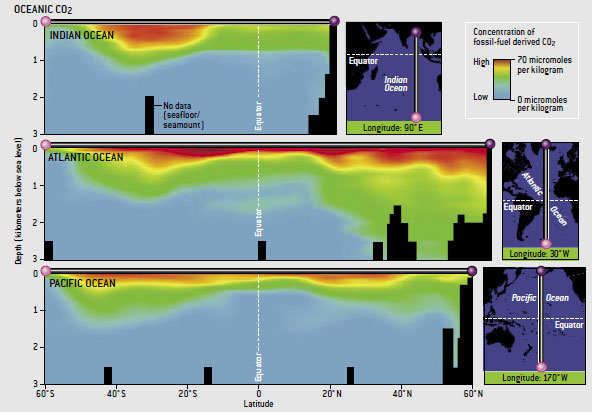

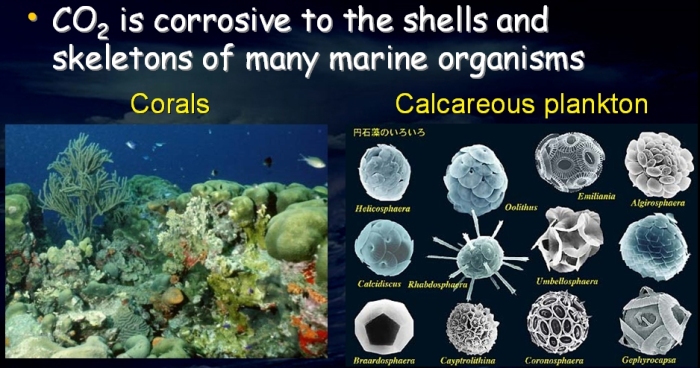
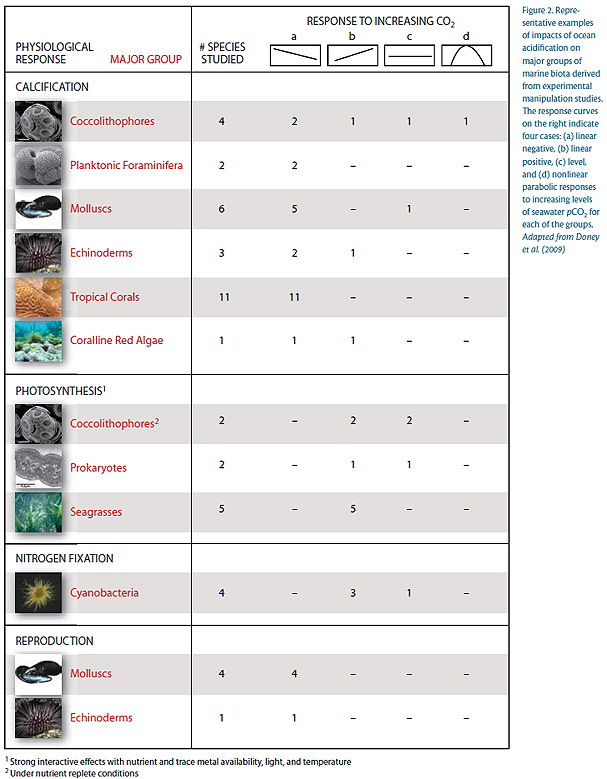
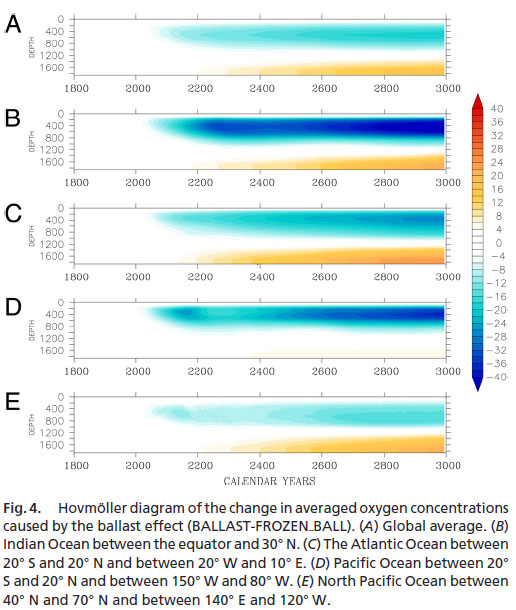
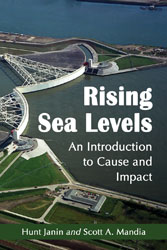

Great post. I was wondering what the projections for ocean acidification were so this was very helpful. You did a great job explaining the basic process, too.
climatesight
June 6, 2010 at 10:43 am
Lets hope you have the same luck with ocean acidification as you did with global warming.
None.
Ray
June 6, 2010 at 6:45 pm
Excellent write up! I tend to be lazy going into so much detail – I might refer to your page in the future 🙂
Ray obvious still feels Monckton deserves credit and certainly doesn’t understand basic chemistry – but you don’t need to convince everyone (I’ve come to understand). I’ve gained similar criticism due to my argument that AGW climate change is only one of a number of issues that could be dealt with using one stone; a shift away from fossil fuels.
Unfortunately our oceans are undergoing a number of terrible changes that are largely ignored due to being on the peripheral of our awareness.
It’s definitely not a case of luck Ray, more concern that fellows like yourself are unable to see. If you want to see evidence of climate change, I urge you to ask any multi-generational farmer; they can tell you that conditions are not like they were when they watched their fathers farm. You don’t need a great dealt of scientific understanding to note such colloquial changes, you just need to avoid the ignorance inherent with living in a little concrete box.
Cheers
Tim
June 6, 2010 at 7:03 pm
I am a multi generational farmer! I recall brutal winters as a youth, its warmer now and thats a very good thing. I don’t credit humans with having anything to do with this improvement.
The global warming scare has lost traction not only with a growing number of scientist but a majority of voters too. Ocean acidification I suspect will go nowhere.
Ray
June 7, 2010 at 2:41 pm
Ray, the consensus grows stronger every year so I am unsure why you think global warming has lost traction with those in the know?
Scott A Mandia
June 7, 2010 at 6:50 pm
Ray, affirmations are supposed to be a private matter.
Doug Bostrom
June 7, 2010 at 7:03 pm
Well done – I will forward this on. Thank you very much!
John
June 7, 2010 at 11:05 pm
Thank-you for this Scott.
Amoeba
June 7, 2010 at 11:52 pm
Ray,
“I am a multi generational farmer! I recall brutal winters as a youth, its warmer now and thats a very good thing.”
So you say it’s warmer (which the analysis also makes quite clear) and yet you think that global warming is just a scare/myth? That’s like saying that you feel ill, but it’s not because you’re eating off-meat.
It might be working in your favour at the moment, but that won’t always be the case. In southern Australia for instance, it is very likely that we’ll see more of these big-dry and big-wets as our environment tends towards more subtropical climates. Current farming through the southern regions of Australia are such that a whole heap more of our top-soil will be lost with the dries and the big down-pours.
Shrugging off the changes that you’ve noticed yourself will only mean that farmers that think like you will suffer a lot of disappointing years until they accept the change.
Climate change has not lost traction and much of the scientific community is busy studying it and discussing it. Many governance bodies are also getting their hands on the world to better prepare. I know this because I’m generally sitting in some meeting listening to it all.
Voters and polls prove nothing about scientific evidence; the natural world doesn’t follow our consensus – polls only show how easily people follow charisma rather than logic.
As for ocean acidification. If you’ve got some time, get a bottle, tap water, a soda stream and the pH strips – it’s not a hard experiment. Test the pH before and after you pump CO2 into the water.
Anyone who saw the effects of acid rain knows what acid does to lime buildings/statues; the same will happen to calcium carbonate shells. Sure, carbonic acid is only weak, however unlike the rain, they’re bathing in it all the time. It will reduce the fitness of any shelled oceanic life form.
mothincarnate
June 8, 2010 at 12:18 am
hands on the world? lol.. hands on the current literature to better prepare.
mothincarnate
June 8, 2010 at 12:21 am
Ray is apparently right about one thing: the issue is “losing traction” at least among the British public.
According to this:
http://www.guardian.co.uk/environment/2010/feb/23/british-public-belief-climate-poll
“The proportion of adults who believe climate change is “definitely” a reality dropped by 30% over the last year, from 44% to 31%, in the latest survey by Ipsos Mori.”
VoxRat
June 8, 2010 at 10:21 am
VoxRat,
Do you understand that the public perception [consensus] concerning the science of climate change is NOT the same as the scientific consensus concerning climate change?
It’s not entirely clear that you do understand the difference. It seems likely that you confuse the two.
FYI, scientific consensus derives from the unequivocal overwhelming imbalance of the evidence.
BEYOND THE IVORY TOWER – The Scientific Consensus on Climate Change
Click to access 1686.pdf
Examining the Scientific Consensus on Climate Change
[quote]…1. When compared with pre-1800s levels, do you think that mean global temperatures have generally risen, fallen, or remained relatively constant?
2. Do you think human activity is a significant contributing factor in changing mean global temperatures?
With 3146 individuals completing the survey, the participant response rate for the survey was 30.7%. This is a typical response rate for Web-based surveys [Cook et al., 2000; Kaplowitz et al., 2004]. Of our survey participants, 90% were from U.S. institutions and 6% were from Canadian institutions; the remaining 4% were from institutions in 21 other nations. More than 90% of participants had Ph.D.s, and 7% had master’s degrees. With survey participants asked to select a single category, the most common areas of expertise reported were geochemistry (15.5%), geophysics (12%), and oceanography (10.5%). General geology, hydrology/hydrogeology, and paleontology each accounted for 5–7% of the total respondents. Approximately 5% of the respondents were climate scientists, and 8.5% of the respondents indicated that more than 50% of their peer- reviewed publications in the past 5 years have been on the subject of climate change. While respondents’ names are kept private, the authors noted that the survey included participants
with well-documented dissenting opinions on global warming theory.
Results show that overall, 90% of participants answered “risen” to question 1 and 82% answered yes to question 2. In general, as the level of active research and specialization in climate science
increases, so does agreement with the two primary questions (Figure 1). In our survey, the most specialized and knowledgeable respondents (with regard to climate change) are those who listed climate science as their area of expertise and who also have published more than 50% of their recent peer-reviewed papers on the subject of climate change (79 individuals in total). Of these specialists, 96.2% (76 of 79) answered “risen” to question 1 and 97.4% (75 of 77) answered yes to question 2….[endquote]
Click to access 012009_Doran_final.pdf
Scott’s website is full of the science, I suggest you do some reading! Intelligent genuinely sceptical people look at the evidence and then decide, based upon the evidence. Their position would change, should the balance of evidence alter. Thus far, the balance of the evidence is changing, the evidence for anthropogenicity is increasing, not decreasing.
Another helpful subject: the Dunning-Kruger Effect. http://tinyurl.com/2ds6out
Try ‘Illusion of Superiority’.
Amoeba
June 10, 2010 at 1:25 am
From VoxRat’s link :
“Thirty one percent of those polled said climate change was ‘definitely’ happening, while 29% said it ‘it’s looking like it could be a reality’, and another 31% said the problem was exaggerated, a category which rose by 50% compared to a year ago. Only 6% said climate change was not happening at all, and 3% said they did not know.”
Which means that 60% accept climate change is or is likely to happen. That’s a majority, isn’t it, even after all the bluster about Climategate, conspiracies and allegations of fraud, etc ? Better than anyone could have expected, I reckon.
JMurphy
June 8, 2010 at 10:50 am
Mothincarnate It would be an education for you to have been a member of the Vikings who’s village froze off the coast of Greenland at the end of MWP. Often change is neither good or bad, its just differant.
Scott, as soon as I saw you quote Steve Schneider, I could not read the rest.
Ray
June 9, 2010 at 7:26 pm
It’ll certainly be an education for you if you do not meet the needs of a changing climate if you are, as you say, a farmer. Yours is the naivety that is counter productive to meeting the challenges over the next century.
I’m sure, if your Vikings understood climate as we now do, those with foresight would’ve made the move while those that think like yourself would’ve continued to try to work frozen earth.
Beside that, the factors of the MWP and the shape of the temperature trends are nothing to that we’re seeing today.
Tim
June 9, 2010 at 8:41 pm
Ray
If the science is losing traction among scientists, what do you make of my two lists below? Remember the groups in List 1 are who you presume to know better than.
LIST #1 The following scientific organizations support the findings of the IPCC.
National Academy of Sciences (U.S.)
NASA
Woods Hole Resesarch Center
US Geological Survey (USGS)
National Center for Atmospheric Research (NCAR)
NASA’s Goddard Institute of Space Studies (GISS)
American Association of State Climatologists
Federal Climate Change Science Program, 2006 (the study authorized and then censored by Bush)
American Chemical Society – (world’s largest scientific organization with over 155,000 members)
Geological Society of America
American Geophysical Union (AGU)
National Oceanic and Atmospheric Administration (NOAA)
American Association of State Climatologists
Environmental Protection Agency (EPA)
American Astronomical Society
American Institute of Physics
American Meteorological Society (AMS)
American Association for the Advancement of Science (AAAS)
Stratigraphy Commission – Geological Society of London – (The world’s oldest and the United Kingdom’s largest geoscience organization)
Chinese Academy of Sciences
Royal Society, United Kingdom
Russian Academy of Sciences
Royal Society of Canada
Science Council of Japan
Australian Academy of Sciences
Royal Flemish Academy of Belgium for Sciences and the Arts
Brazilian Academy of Sciences
Caribbean Academy of Sciences
French Academy of Sciences
German Academy of Natural Scientists
Indian National Science Academy
Indonesian Academy of Sciences
Royal Irish Academy
Accademia Nazionale dei Lincei (Italy)
Academy of Sciences Malaysia
Academy Council of the Royal Society of New Zealand
Royal Swedish Academy of Sciences
Union of Concerned Scientists
The Institution of Engineers Australia
Canadian Meteorological and Oceanographic Society (CMOS)
National Research Council
Canadian Foundation for Climate and Atmospherice Sciences
World Meteorological Organization
State of the Canadian Cryosphere (SOCC)
International Council on Science
Get ready for List #2 drum roll please..
LIST #2 The following scientific organizations Do Not support the findings of the IPCC.
American Association of Petroleum Geologists (AAPG)
Canadian Association of Petroleum Geologists (CAPG)
That is the whole list.
sailrick
June 10, 2010 at 2:00 am
Ray, one thing that you fail to understand, is that it is the rate of temperature change that is dangerous. Already spring and fall are way off their normal timing, making it difficult for species to adapt their feeding and migrating and breeding patterns. That’s with about 35% increase in CO2 concentrations in industrial times. At our business as usual rate of emissions, we will see 100-200% increase by the end of the century. A doubling or even tripling of CO2 concentration. And it will not be easy for modern man, with vast cities, infrastructure, agriculture etc, to adapt to very fast changes. We are no longer nomads, who can just move. There are 6 billion of us in a highly industriali zed world, now, doing what has never before been done on the planet. We are the most powerful force on the planet. The complete opposite of the skeptic argument I hear so often, that says man is too small to effect the planet globally. Nonsense. Look around you.
Look at it this way. You have probably heard of carbon sequestration for clean coal. CO2 would be pumped deep into the earth to take carbon out of the short carbon cycle, (atmosphere, ocean, living things, topsoil that carbon “cycles” through. This cycle has had a certain balance for a long long time, that makes the world as we know it, with the life forms we know, possible.
Think of coal as a form of carbon sequestration. Carbon that was in living things, and hence in the carbon cycle, got sequestered in the earth when those living things died. It took 65 million years for this process to produce the coal we burn. We are now putting that 65 million years of sequestered carbon back into the atmosphere and ocean, and the carbon cycle, in a few hundred years.
Assuming 200 years, that’s 325,000 times faster than it was taken out of the carbon cycle. That has never happened before. That is not a natural cycle.
sailrick
June 10, 2010 at 2:01 am
it will not be easy for modern man, with vast cities, infrastructure, agriculture etc, to adapt to very fast changes. We are no longer nomads, who can just move. There are 6 billion of us in a highly industriali zed world, now, doing what has never before been done on the planet.
I am currently working on the addition of quite a few Web pages that will summarize the Impact of Climate Change. I will likely post them here “as I go” before launching that new section of my site. Stay tuned….
Scott Mandia
June 10, 2010 at 8:33 am
I’ll have to stay tuned about that Scott; I’m currently doing something similar under the title “Innovation is key to the survival of our society”. I’m, at this point, looking at the facts as best we know them, then what this will mean if allowed to develop further before ending with arguments of how we could be innovative to avoid collapse etc (which the denialists illustrate will occur if we do change, but the evidence suggests will happen if we don’t change); keeping each part under 800 words..
🙂
Tim
mothincarnate
June 10, 2010 at 5:10 pm
That a large gorilla in the ocean cannot be ignored is self-evident. Why do you think there have been so many ‘King Kong’ remakes?
Otherwise, a very informative post.
Roger Romney Hughes
June 11, 2010 at 11:02 pm
[…] Reefs have deteriorated as a result of a combination of human impacts such as over fishing and pollution from adjacent land masses, together with an increased frequency and severity of bleaching and ocean acidification associated with climate change. (See my blog post about ocean acidification titled: The 800 lb. Gorilla in the Ocean) […]
Global Warming: A Sea Change « Global Warming: Man or Myth?
June 21, 2010 at 6:03 am
[…] Mandia offers a lesson after picking himself up off the floor reading Willis Eschenbach’s latest demonstration of […]
Website News « Wott's Up With That?
June 25, 2010 at 10:20 pm
Scott,
Thank you for an excellent primer on ocean acidification and chemistry. Superb. I will do my part to spread the word about it.
dan Satterfield
July 5, 2010 at 2:27 am
[…] Reefs have deteriorated as a result of a combination of human impacts such as over fishing and pollution from adjacent land masses, together with an increased frequency and severity of bleaching and ocean acidification associated with climate change. (See my blog post about ocean acidification titled: The 800 lb. Gorilla in the Ocean) […]
Climate Change Impact on Oceans & Shallow Seas « Global Warming: Man or Myth?
August 22, 2010 at 3:59 pm
[…] The 800 lb. Gorilla in the Ocean […]
Top 10 Blog Posts « Global Warming: Man or Myth?
September 8, 2010 at 5:59 am